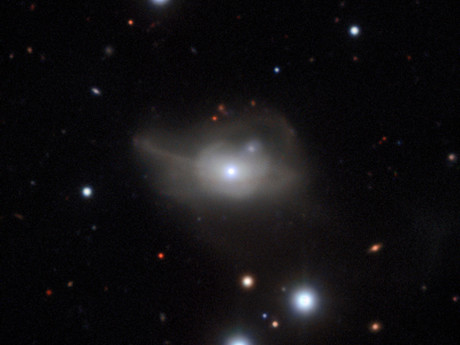The mystery of the dimming galaxy and the starving black hole

An international team of astronomers has discovered the secret behind a change in the behaviour of a supermassive black hole at the centre of a distant galaxy.
Utilising the European Southern Observatory’s (ESO) Very Large Telescope, along with the Hubble Space Telescope and NASA’s Chandra X-ray Observatory, the researchers suggested that the black hole is no longer being fed enough fuel to make its surroundings shine. Their work has been presented across two papers in the journal Astronomy & Astrophysics.
Many galaxies are found to have an extremely bright core powered by a supermassive black hole. They are thought to shine so brightly because hot material is glowing fiercely as it falls into the black hole, a process known as accretion. This brilliant light can vary hugely between different active galaxies, so astronomers classify them into several types based on the properties of the light they emit.
Some of the galaxies have been observed to change dramatically over the course of a decade or two. This was the case with the subject of this latest study, Markarian 1018, which changed from a dim ‘type 1.9’ galaxy during its initial observation in 1974 to a bright ‘type 1’ galaxy in 1984. However, the galaxy’s optical continuum brightness dropped by an order of magnitude between 2010 and early 2016, causing it to revert back to its initial classification.
“We were stunned to see such a rare and dramatic change in Markarian 1018,” said Rebecca McElroy from the University of Sydney and the ARC Centre of Excellence for All Sky Astrophysics (CAASTRO), whose team were conducting routine observations of the galaxy with the Multi-Unit Spectroscopic Explorer (MUSE) installed on ESO’s Very Large Telescope when they noticed the surprising change in the light output.
“We were lucky that we detected the event just 3–4 years after the decline started, so we could begin monitoring campaigns to study details of the accretion physics of active galaxies that cannot be studied otherwise,” added Bernd Husemann, project leader of the Close AGN Reference Survey (CARS).
The research team made it their first priority to pinpoint the process causing Markarian 1018’s brightness to change so wildly, which could have been caused by any one of a number of astrophysical events. After being allowed use of the Hubble Space Telescope and the Chandra X-ray Observatory, they were able to solve the mystery — the black hole at the centre of the galaxy was being starved of accretion material.
“It’s possible that this starvation is because the inflow of fuel is being disrupted,” said McElroy. “An intriguing possibility is that this could be due to interactions with a second supermassive black hole.” Such a black hole binary system is a distinct possibility in Markarian 1018, as the galaxy is the product of a major merger of two galaxies — each of which likely contained a supermassive black hole in its centre.
Since the initial discovery of Markarian 1018’s dimming in 2015, the team has been able to confirm the galaxy’s brightness is further decreasing. According to Husemann, future research will allow the researchers to further explore the world of starving black holes and changing galaxies in more detail.
Solar-powered reactor uses CO2 to make sustainable fuel
Researchers have developed a reactor that pulls carbon dioxide directly from the air and converts...
Scientists simulate the effects of an asteroid collision
How would our planet physically react to a future asteroid strike? Researchers simulated an...
2024 was warmest year on record, 1.55°C above pre-industrial level
The World Meteorological Organization says that 2024 was the warmest year on record, according to...




